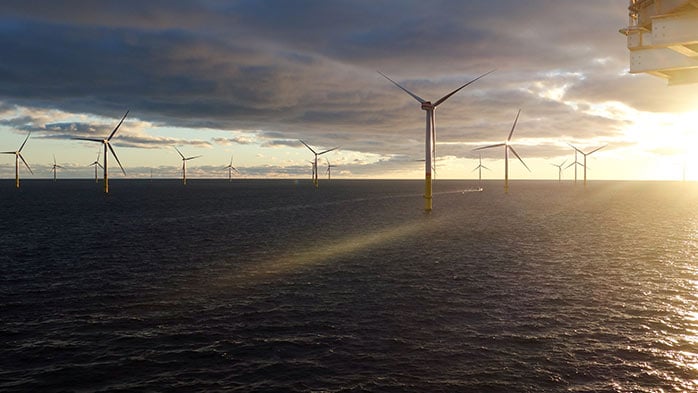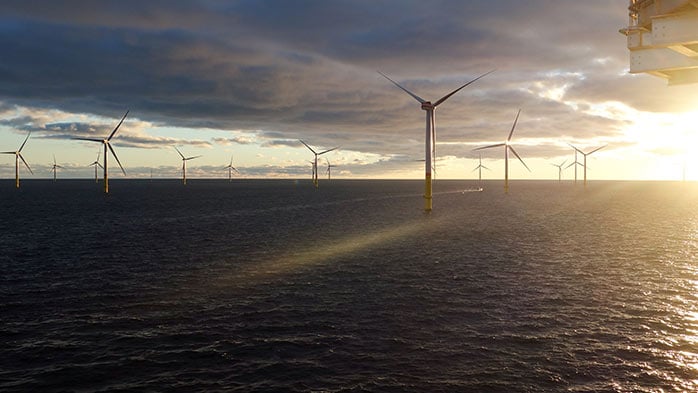The UK Clean Power 2030 plan will mean higher underlying electricity costs, due to the cost of firming renewables output rather than the cost of renewables themselves. How this affects consumers – industrial, commercial and domestic – depends on how current taxes and levies are redistributed.
While focused on the UK, the conclusions here have wider relevance to all countries that are decarbonising grids and on power costs. We will follow this insight with others going into more detail on this subject.
Power prices will rise under the UK Clean Power 2030 plan
The UK government plans to decarbonise the UK electricity grid by 2030, and a report by the National Energy System Operator (NESO) – commissioned by the UK government and published in late-2024 – set out how this could be achieved (n.b. the plan assumes ~5% fossil-based power in a decarbonised grid). Much has been made of a key conclusion that “consumers would be no worse off” under the plan.
However, the counterfactual case in the report is the continuation of the current gas-dependent grid with an assumption that the carbon price will rise to £172 /tCO2 and gas prices will be at £9.5 /GJ. Based on extant prices when the report was being finalised, these assumptions suggest wholesale-equivalent electricity prices would rise by ~£57 /MWh – or ~72% – under the counterfactual case, assuming gas-based power remains the main price setter, and this is what a decarbonised grid is compared against.
While we can debate future prices of gas and carbon, the overall conclusion that a decarbonised UK grid could see firmed electricity costs rise by 70–75% from today – a time when power prices are already elevated due to high gas prices – appears at odds with expectations that a decarbonising grid will bring about lower electricity prices.
This insight explores why this is the case.
Underlying renewables cost is only one component of total costs
On moving to a renewables (RE)-heavy grid, there are several considerations beyond simply the underlying cost of the RE. These include:
- Variability of RE and the need to make the output ‘firm’
- Optimal mix of solar and wind to minimise firming costs
- Optimal degree of RE overbuild and curtailment to smooth the output profile and further minimise firming costs
- Role of batteries to smooth short-term variations
- Role of flexible fossil power to smooth both short-term and seasonal variations
- Cost uplift of flexible fossil power operating at very low load factors
- Role of demand management/flexibility
The role and cost of these different considerations is explored below, using models of optimised grid configurations.
Firming renewables is a big challenge
Below, we use an optimum solar:wind RE profile for northern Europe to determine total grid power costs at different RE penetration rates. Costs consider battery storage at 50% daily RE output to accommodate daily fluctuations in supply, an optimum level of overbuild to both smooth RE output and minimise supply deficits, and the cost uplift associated with fossil power plants operating at low-capacity utilisations. The role of demand flexibility will be explored in a follow-up insight. From this point on, all analysis is in US dollars.
Costs shown take account of the capital and operating costs of RE and battery storage, as well as capital and operating costs of fossil power plants. While these factors cover the majority of costs, they are not comprehensive. Therefore, they have been labelled as a ‘power cost index’ here.
Fossil power plants are assumed to be gas-based – natural gas is priced at $6.5 /GJ and carbon at $20 /tCO2 to reflect pre-energy crisis gas power costs. RE and battery costs broadly reflect expected costs in 2030 in real 2024 terms. Other generating types, such as nuclear and hydro, are ignored here (i.e. it is assumed they won’t play a role in smoothing variable RE output by operating flexibly – rather, they will operate independently) – only the RE/fossil component of the grid is examined. Thus, the costs shown are those associated with the fossil/RE component of a grid only so the overall cost of power on the grid will also depend on the contribution made by nuclear, hydro and others to the final mix.
The chart shows that, as the grid moves from 100% fossil-based power to ~95% RE-based power, the underlying costs of firm power rise by ~150% from pre-energy crisis levels, to as much as ~$170 /MWh. Interestingly, this cost is approximately the same as, if not higher than, the contracted price for power from Hinckley Point C.
The modelled uplift is higher than the ~72% price uplift implied by the NESO report for the UK grid moving to ~5% fossil-based power, but the start points differ. Using today’s gas and carbon prices (i.e. ~$11.2 /GJ and ~$50 /tCO2 respectively), the 100% fossil case would be higher by ~$40 /MWh, limiting the modelled cost increase to ~55% and closer to the NESO value (n.b. the increase would be ~60% using a carbon price of £172 /tCO2 as used in the NESO report).
Regardless of the start point, what is driving the cost increase for UK clean energy? Here, the cost uplift is tracked at increasingly higher RE penetration rates and broken down into different cost categories.
As RE penetration lifts (x-axis), the cost of the ‘core RE’ – that provides the requisite quantity of electrons to the grid to satisfy demand (i.e. the bottom two blue and purple bars) – remains on a par with, or even just lower than, the equivalent fossil-based power. This could be interpreted as leading to a similar wholesale electricity price. However, the added costs associated with overbuild, grid batteries, cold start batteries for flexible fossil plants and the fixed costs associated with the fossil plants are, combined, a much more significant proportion of overall costs.
This outcome demonstrates the increasing irrelevance of ‘wholesale price' – as currently defined – as an indicator of underlying power costs, given electricity costs will increasingly be influenced by firming costs of one sort or another over and above the underlying cost of the power.
The messaging around the UK Clean Power 2030 plan has focused on the fact that electricity costs will not be any higher than might have been expected otherwise, but this is based on a counterfactual that assumes a carbon price of £172 /tCO2 and an elevated gas price. In reality, the NESO report sets out that electricity prices in the UK are expected to rise relative to today under the plan.
Despite this, it is CRU’s view a decarbonising grid remains the lowest-cost option for significant decarbonisation of the UK economy. However, pretending this will not lead to higher costs will, ultimately, be a barrier to progress. We believe more honest conversations are needed about what can be done, and coupled with costs, this will lead to greater acceptance and faster progress. As it is, if the UK Clean Power 2030 plan starts to be successfully rolled out – which remains questionable – the UK government will certainly see resistance as electricity prices start to rise. This will hinder progress.
It is too naïve to simply say that “renewables are cheaper than fossil power” as there are complexities in how grids will be decarbonised that have major implications for power costs. The bulk of costs will be associated with firming renewables.
If power costs are important to you, contact us and we’ll be happy to discuss our ideas and thoughts.

















